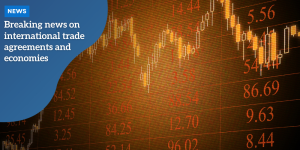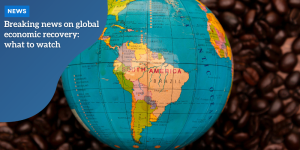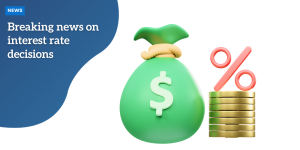Breaking news on global economic recovery trends

Anúncios
Breaking news on global economic recovery emphasizes that key factors such as technological advancements, government policies, and global trade are driving future growth while challenges like supply chain disruptions and inflation persist.
Breaking news on global economic recovery highlights significant shifts that could influence our daily lives and financial stability. Have you noticed how certain sectors are bouncing back while others continue to struggle? Let’s dive into the details.
Current global economic indicators
Understanding current global economic indicators is crucial for predicting trends and making informed decisions. These indicators help us gauge the health of economies around the world and can influence both business strategies and personal finance.
Anúncios
Key Indicators to Watch
There are several key indicators that economists pay attention to when analyzing economic conditions:
- Gross Domestic Product (GDP): This is the total value of goods and services produced in a country. A rising GDP indicates economic growth.
- Unemployment Rate: This measures the percentage of the labor force that is unemployed and actively seeking work. Lower rates generally suggest a healthier economy.
- Consumer Price Index (CPI): This index tracks changes in the price level of a market basket of consumer goods and services, reflecting inflation.
- Interest Rates: Central banks set interest rates to control inflation. Lower rates can stimulate borrowing and investment, while higher rates may slow the economy down.
These indicators do not operate in isolation; they are interconnected. For example, an increase in the GDP may lead to a decrease in the unemployment rate as businesses expand and hire more workers. Similarly, a high CPI may prompt central banks to increase interest rates to manage inflation. Understanding these relationships can give us deeper insights into economic trends.
Regional Variations in Indicators
It’s important to consider that global economic indicators can vary significantly from one region to another. Developed countries often experience different economic challenges compared to developing nations. For instance, while GDP growth may be robust in one area, another may face stagnation due to political instability or natural disasters.
In addition, trade relations can impact these indicators. Countries heavily reliant on exports may struggle if global demand decreases, while those with diverse economies may remain stable. Monitoring regional economic performances helps stakeholders make more accurate forecasts and adjust strategies accordingly.
Key factors driving recovery
Several key factors driving recovery in the global economy play critical roles in shaping financial landscapes. Understanding these factors can provide insights into how economies bounce back after downturns.
Anúncios
Government Policies
Government interventions can significantly impact economic recovery. Policies such as fiscal stimulus, tax cuts, and increased public spending can create jobs and boost demand. When people have more money to spend, businesses often see increased sales, which can lead to further hiring and investment.
- Fiscal Stimulus: Governments may invest in infrastructure projects, which not only create jobs but also enhance productivity.
- Tax Incentives: Reducing taxes for individuals and businesses encourages spending and investment.
- Monetary Policy Adjustments: Central banks may lower interest rates to make borrowing cheaper, stimulating investment and spending.
Another important aspect is consumer confidence. When consumers feel secure about their jobs and the economy, they are likely to spend more. This spending can drive growth as businesses respond to increased demand. Factors such as low unemployment rates and job security contribute to this sense of confidence.
Technological Advancements
In addition to government actions, technological advancements often play a vital role in economic recovery. Innovations can create new industries and enhance productivity across existing ones. For instance, advancements in e-commerce and remote working technologies have allowed businesses to adapt during challenging times.
Moreover, companies investing in technology tend to emerge stronger after a downturn, as they can streamline operations and reach customers more effectively. This shift can lead to job creation in tech-related fields, further supporting recovery.

Challenges facing global economies
Global economies face a variety of significant challenges that can hinder recovery and growth. Understanding these challenges is essential for investors, businesses, and policymakers. By addressing these issues, countries can better prepare themselves for a more resilient future.
Supply Chain Disruptions
One major challenge is the disruption of global supply chains. Events like the pandemic and geopolitical tensions have shown how fragile these networks can be. When supply chains are disrupted, it leads to shortages, increased costs, and delays. Businesses may struggle to obtain the raw materials they need, affecting production.
- Increased Costs: Companies may need to pay more for materials, which can lead to higher prices for consumers.
- Logistical Issues: Transportation delays can result in products not reaching markets on time.
- Regional Dependencies: Over-reliance on specific countries for supplies can create vulnerabilities.
These supply chain challenges require businesses to rethink their strategies. Some are exploring local sourcing or diversifying their suppliers to mitigate future risks. This approach can provide a stronger foundation for economic stability.
Inflation Concerns
Another significant challenge is rising inflation. As economies recover, increased demand can lead to higher prices. Central banks may respond by raising interest rates, which can slow economic growth. This balancing act is vital for maintaining economic health.
High inflation affects consumer purchasing power, as people can buy less with the same amount of money. Businesses may also struggle with increased operational costs. Therefore, finding effective ways to manage inflation is critical for sustaining economic recovery.
Future outlook for economic growth
The future outlook for economic growth appears promising, but it is also shaped by many variables. Analysts are closely monitoring how trends unfold across various sectors and regions to assess the trajectory ahead.
Emerging Technologies
One significant factor influencing future growth is the rise of emerging technologies. Innovations in artificial intelligence, renewable energy, and biotechnology are expected to drive economic transformation. These advancements often create new markets and opportunities for investment.
- Artificial Intelligence: Companies leveraging AI can significantly increase productivity and operational efficiency.
- Renewable Energy: As the world shifts to greener solutions, investment in renewable technologies is poised to grow.
- Telehealth Services: The pandemic has accelerated the adoption of telemedicine, creating a new sector with substantial growth potential.
As these technologies continue to develop, they will likely enhance global competitiveness and economic resilience. Organizations that adapt to these changes will often thrive in the new landscape.
Global Trade Dynamics
Another critical element in the future outlook is the evolution of global trade dynamics. Trade agreements and international relations can either foster growth or create barriers. Countries that engage in free trade tend to benefit from access to wider markets.
Moreover, geopolitical considerations have made many nations rethink their supply chains. By diversifying trade partners and strengthening regional collaborations, countries can better position themselves for sustained growth. This shift can create a more interconnected global economy, reducing the risks associated with over-reliance on a single nation.
FAQ – Frequently Asked Questions about Global Economic Recovery
What are the key factors driving global economic recovery?
Key factors include government policies, consumer confidence, technological advancements, and global trade dynamics that influence economic growth.
How do supply chain disruptions impact economies?
Supply chain disruptions can lead to shortages and increased costs, affecting production and sales for businesses globally.
What role does consumer confidence play in economic growth?
Consumer confidence affects spending patterns; when consumers feel secure, they tend to spend more, which drives economic growth.
How can emerging technologies affect future economic growth?
Emerging technologies create new markets and improve efficiency, potentially leading to significant economic transformation and growth.






